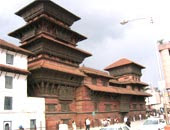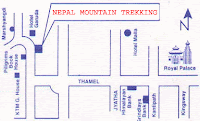
Travel Search
Sunday, December 6, 2009
MUKTINATH

Friday, December 4, 2009
JALESHWAR MAHADEV

Thursday, December 3, 2009
DEVGHAT

Saturday, November 28, 2009
DOLAKHA BHIMSEN

DAMAN

Friday, November 27, 2009
GORKHA

JANAKPUR

Wednesday, November 25, 2009
LUMBINI

BANDIPUR

NATURLLY BEAUTY IN NAGARKOT

Tuesday, November 24, 2009
PASHUPATINATH
 This is the holiest of all the Shiva shrines in Nepal and is the abode of Lord Pashupatinath, the guardian spirit of Nepal. The temple of Pashupatinath is a large double-roofed pagoda of brass and gilt goad; the gateway is plated with silver. It stands on the western bank o the Bagmati, about five Kilometers north-east of Kathmandu and contains the sacred linga of Lord Pashupatinath. Before the Temple stands an enormous gilt filigree of the bull Nandi, the mount of Shiva, flanked by a golden trident. There is a crematorium outside the temple by the side of the wide but shallow river and the wooded surroundings are dotted with small shrines. On the occasion of the annual festival of Maha Shivaratri(February/March). the temples is visited by thousands of devotees including a large number of pilgrims from India. The temple is also the site of a number of other festivals and rituals taking place throughout the year.
This is the holiest of all the Shiva shrines in Nepal and is the abode of Lord Pashupatinath, the guardian spirit of Nepal. The temple of Pashupatinath is a large double-roofed pagoda of brass and gilt goad; the gateway is plated with silver. It stands on the western bank o the Bagmati, about five Kilometers north-east of Kathmandu and contains the sacred linga of Lord Pashupatinath. Before the Temple stands an enormous gilt filigree of the bull Nandi, the mount of Shiva, flanked by a golden trident. There is a crematorium outside the temple by the side of the wide but shallow river and the wooded surroundings are dotted with small shrines. On the occasion of the annual festival of Maha Shivaratri(February/March). the temples is visited by thousands of devotees including a large number of pilgrims from India. The temple is also the site of a number of other festivals and rituals taking place throughout the year. Monday, November 23, 2009
BEAUTY IN NEPAL
 BHAKTAPUR
BHAKTAPURBhaktapur or Bhadgaon as the city is also known, is a museum of medieval art and architecture with many fine examples of sculpture, woodcarving and colossal pagoda temples consecrated to different gods and goddesses. The city is shaped like a conch shell-one of the emblems of the god Vishnu and was founded by King Ananda Deva in A.D. 889. The city is 1,402 meters above sea level. Pottery and weaving are its major traditional industries. The city lies fifteen kilometers to the east of Kathmandu.
Sunday, November 22, 2009
KRISHNA TEMPLES

PATAN DURBAR SQUARE

Saturday, November 21, 2009
TUNDHIKHEL & SINGHA DURBAR

Wednesday, November 18, 2009
MACHCHHENDRANATH TEMPLE AND AKASH BHAIRAV TEMPLE


Tuesday, November 17, 2009
BHAGAVATI TEMPLE

KASTA MANDAP

Monday, November 16, 2009
KUMARI CHOWK

MUL CHOWK(PATAN)

TALAJU MANDIR

Sunday, November 15, 2009
BASANTAPUR CHOWK

KATHMANDU(HANUMAN DHOKA)

Saturday, November 14, 2009
The People in Nepal

Climate and Rainfall

Lakes

Thursday, November 12, 2009
Manaslu Himal Trek

Lamjung Himal Treak

Nepal Mountain Trekking

Name of Trekking
Camping/Lodge
Days
Lamjung Himal trek/Rafting/safari/sightseeing
Camping
16 days
Manaslu trek
Camping
16 days
Round Annapurna trek
Logde
20 days
Round Dhaulagiri trek
Camping
16 days
Makalu Base Camp trek
Camping
25 days
Sacred Mountain "Mt. Kailash" trek
Camping
25 days
Langtang Valley trek
Lodge
16 days
Rolwaling Himal trek
Camping
22 days
Panchase hill trek
Camping
6 days
Panchase poon hill trek
Camping
10 Days
Langtang / Helambu trek
Lodge
6days
Classic Nepal "Annapurna Sanctuary" trek
Lodge
19 days
Everest / Tyangboche trek
Lodge
7 days
Gokyo Lakes trek
Lodge
12 days
Everest Base Camp & Kalapatthar trek
Lodge
16 days
Helambu village trek
Lodge
6 days
Nepal Trekking Ageny
We cordially welcome to Welcome Nepal Treks and Tours Pvt. Ltd. Welcome Nepal Treks and tour is a adventure and leisure Nepal travel and Nepal trekking agency for discount travel and trekking. We are leading Nepal Travel and Trekking company with Nepal government and many travel and trekking association registered.Welcome Nepal Travel and Trekking agency offering details of tours, leisure holiday, special honeymoon package tours, himalaya trekking, adventure vacation and mountaineering, eco tours, media tourism like filming in Nepal, India, Bhutan, local city sightseeing, air ticketing, accommodation and adventure activities. Online booking are always available.Our motto is "Where there is greenery, there is peace and happiness".
It is our pleasure to present Welcome Nepal Treks P.Ltd is the largest full service trekking and tour operator in Nepal. As a members of The Trekking Agents Association of Nepal, The Nepal Mountaineering Association, The Kathmandu Environment Education Project and The Nepal Tourism Board, we are absolutely familiar with the destinations we offer. Our main focus is meeting the needs and ensuring the safety of mountaineers, trekkers, geologists, scientists and anthropologists. Our aim is introduce Nepal to the world without impacting on the precious ecology of our beloved country. We take pride in providing first rate services to each valued guest. We believe that beautiful surroundings alone do not make an unforgettable holiday - a thorough knowledge of the terrain and carefully planned arrangements for your safety and comfort are equally important.
Our excellent record of customer satisfaction and continued success has led us to expand our range of services. We always try to ensure that our clients receive the most accurate and efficient service,guaranteeing you quick answers to your enquiries and repid confirmation of your booking request.Welcome Nepal travel,welcome Nepal trekking agency and our staff hope that you will find on our website for your requirements.if you have any question ,comments or suggestion please write to us email.
We are very humbly request you, please do not hesitate to write us for more information and further details for your trip to Nepal. Thanks and wishing you all the best for your memorable and safe journey to this exotic land.
History of Travel in Nepal

Wednesday, November 11, 2009
Trekking in Mt. Everest

Cultural Differences

Culture is tourism's main arrtaction without culture, every place would be seen ironically the same. Without different cultural heritage, the places around the world would have little. so offer that could attract the purpose of tourism.
The chices of interest of determined by the age, sex, culture and nationality such as children are interested to play & enjoy, Young generation like to be informal & take part in adventure activities where as older generations are more disciplined, formal enjoy culture tours. Choice of food & eating pattern differ as per nationality for eg. we use our hand fot eating, some use soon, forks, chopsticks etc. Indian & Japanise prefer to have their own foods, Americans and Europeans want in their meals.
Travel
Tuesday, November 10, 2009
Travel Nepal

Nepal is naturally beauty country.It's wealth of nature.Here is a lot of beautyful places, theseplaces are Historical Places, Natural Caves, Flora and Funa, Himalyan, Treeking sport, Hotels,Manmade architectue, rivers, lake are most important places. People they want to know one place to another place and they gain lot of enjoy and knowledge.Now a days Nepal is going increasing number of tourist. They are motivate natural resources and treak.It's a phenomenan of hobbey of human being. Nepal is landlocked and under developing country. About all places are able to visit. The world toppet mt. Everest is located in solukhumbu district of himalyan region. Yearly, a lot of people clambing the mt. Everest. It's 8,834 meters highest. The world famous religious places are Janakpur, Lumbini, Muktinath, Tatopani, Machindranath, Basantapur, Bindabashani, Patan darbar squre(Lalitpur), Pokhara.According to World Travel Agency-''Nepal is temple country'' and It's a staying land of peace. Generally here is a lot of culture activeties.They are Bhaktapur festivel, Bandipur Mahotasab, Ethic culture.